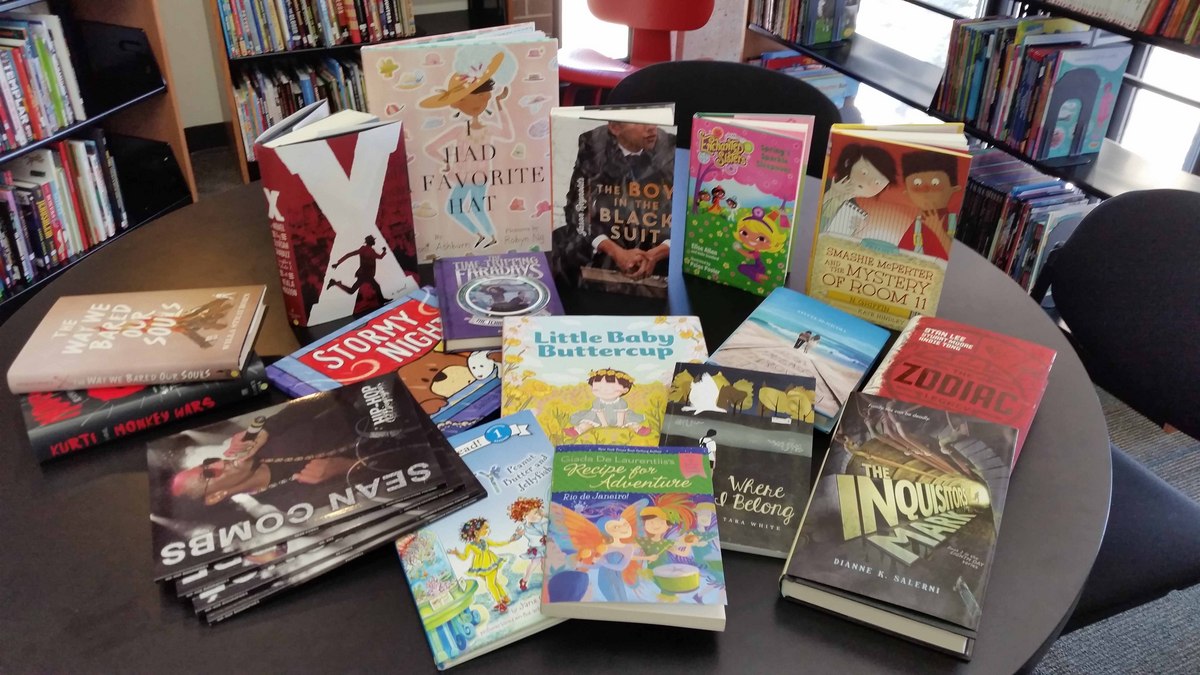UW-Madison center sees hope for more diversity in children’s books

UW-Madison’s Cooperative Children’s Book Center displays a selection of new books by and about people of color that it logged this week. The center compiles annual data on the number of children’s books representing diversity.
Photo: J. Matzner
As the face of America becomes increasingly diverse, the number of children’s books by and about people of color has remained stubbornly stagnant over the past 25 years, according to annual data compiled by UW–Madison’s Cooperative Children’s Book Center.
But the most recent figures, released Wednesday, may contain a sliver of good news for those hoping that kids’ books will one day better reflect the population at large: The number of publications with significant African or African-American content nearly doubled, from 93 in 2013 to 179 in 2014. There was also an increase in the number of books with significant Asian/Pacific or Asian/Pacific American content. It jumped from 69 in 2013 to 112 in 2014.
Kathleen T. Horning
The same can’t be said for books about American Indians and Latinos, however. The numbers for 2014 were nearly the same as those collected in 2013.
“We’ve seen the same old story year after year,” says CCBC Director Kathleen T. Horning. “If the numbers rise one year, they’re likely to fall back the next year. It’s as if there has been a glass ceiling when it comes to diversity in children’s books. The numbers have stagnated throughout most of my career here.”
The CCBC started tracking these numbers in 1985, documenting them in its annual best books listing, “CCBC Choices.” Today the center, housed within UW–Madison’s School of Education, also maintains a website devoted to multicultural literature, including lists of recommended titles by age group.
Shortly after the CCBC started documenting them, Horning noted, the statistics got the attention of the children’s book world.
“People had a sense there weren’t many books out there but they didn’t realize just how bleak it really was until they saw the actual numbers in print,” says Horning.
“The statistics that have been kept by the Cooperative Children’s Book Center are invaluable,” says Jason Low, publisher of Lee & Low Books, which is one of the few minority-owned publishing companies in the United States. “Diversity is the missing piece of the puzzle in children’s books and CCBC has had its finger on the pulse of this issue from the very beginning.”
Last March, The New York Times featured two op-ed pieces that utilized the CCBC figures on the cover of its Sunday Review section, and people haven’t stopped talking about the issue. Horning credits “We Need Diverse Books,” a grassroots movement started last spring to address the problem.
“They have really kept diversity front and center,” says Horning, noting the group’s strong social media presence.
“Publishing is a business. If diverse books sell well, there will be more published. We have to help make that happen by buying the diverse books that are out there. Our kids can’t wait.”
Kathleen T. Horning
“We Need Diverse Books” has found the CCBC’s statistics essential to its mission.
“The data published by CCBC have illustrated the notably minimal growth of diversity in children’s publishing over the last few decades, which is especially pertinent as the population of children of color in the U.S. continues to climb,” says author S.E. Sinkhorn, publicity chair of We Need Diverse Books. “It asks the question for us — why are the already small numbers staying almost exactly the same?”
For the first time in two decades, Horning sees hope on the horizon. “Even though the data we collect indicates children’s literature in this country continues to represent a mostly white world, we see signs that things are changing,” says Horning. “In 2014, for example, we saw a marked increase in the number of novels for children and teens by African-American authors.”
One of them, “Brown Girl Dreaming” by Jacqueline Woodson, won the National Book Award last fall and another, “The Crossover” by Kwame Alexander, won the Newbery Medal earlier this month. Horning also noted that an Asian-American author, Dan Santat, won this year’s Caldecott Medal.
“That’s huge because these awards have an impact on sales,” says Horning.
At the end of the day, Horning says the key to having more diverse books for children is in the hands of consumers.
“The books have to sell,” she says. “Publishing is a business. If diverse books sell well, there will be more published. We have to help make that happen by buying the diverse books that are out there. Our kids can’t wait.”
Subscribe to Wisconsin Ideas
Want more stories of the Wisconsin Idea in action? Sign-up for our monthly e-newsletter highlighting how Badgers are taking their education and research beyond the boundaries of the classroom to improve lives.



